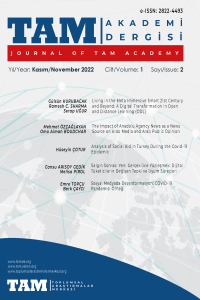Meta Sürükleyici Akıllı 21. Yüzyılda ve Ötesinde Yaşamak: Açık ve Uzaktan Öğrenmede (AUO) Dijital Dönüşüm
Abstract
Açık ve uzaktan öğrenme sistemi dünya çapında milyonlarca öğrenciye hizmet veren köklü bir sistemdir. Dördüncü sanayi devrimi dönemindeki teknolojik gelişmeler, açık ve uzaktan öğrenme sistemini etkilemiştir. Yapay zeka, blok zinciri, 3D baskı, bilgisayarla görme, Nesnelerin İnterneti, davranışların interneti vb.leri öğretme, öğrenme, program geliştirme tasarımı, öğrenme tasarımı, kullanıcı deneyimi, öğrenme sunumu ve değerlendirme sistemlerinde kullanılan akıllı hizmetleri kullanıma sundu. Bu makalede, söz konusu bu ileri teknolojilerin, açık ve uzaktan öğrenmede dijital bir dönüşümü nasıl yapılandırdığı tartışılmaktadır. Öte yandan bu çalışmada; açık ve uzaktan öğrenmenin meta sürükleyici akıllı geleceği de incelenmektedir.
Keywords
Açık ve Uzaktan Öğrenme Meta Sürükleyici Akıllı Gelecek Meta Sürükleyici Akıllı Açık ve Uzaktan Eğitim Gelecek Dijital Dönüşüm
References
- Eden, A. H., Moor, J. H., Søraker, J. H., & Steinhart, E. (2012). Singularity hypotheses: a scientific and philosophical assessment. Springer Berlin Heidelberg Springer e-books Imprint: Springer.
- Kurubacak, G., Sisman-Ugur, S., and Sharma, R. (2021). Immersive Smart Open and Distance Learning (SODL) from 6.0 to 7.0. Learning 321, organized by LMP Education Trust, Gurugram, India, August 07, 2021.
- Kurzweil, R. (2005). The singularity is near: When humans transcend biology. Viking.
- Ugur, S. S., & Kurubacak, G. (2020). Open universities in the future with technological singularity integrated social media. Içinde S. Yu, M. Ally, & A. Tsinakos (Ed.), Emerging Technologies and Pedagogies in the Curriculum (ss. 413-428). Springer Singapore. https://doi.org/10.1007/978-981-15-0618-5_24
Living in the Meta Immersive Smart 21st Century and Beyond: A Digital Transformation in Open and Distance Learning (ODL)
Abstract
Open and distance learning system is now well-established serving millions of students globally. The technological developments in the 4th industrial revolution era have impacted open and distance learning system. Artificial intelligence, blockchain, 3D printing, computer vision, internet of things, internet of behaviour etc. have introduced smart services in teaching, learning, curriculum design, learning design, user experience, instructional delivery and evaluation and assessment systems. In this paper we discuss how such technologies have brought the digital transformation to open and distance learning. We also examine the meta immersive smart future of open education.
Keywords
Open and Distance Learning Meta Immersive Smart Future Meta Immersive Smart Open and Distance Learning Future Digital Transformation
References
- Eden, A. H., Moor, J. H., Søraker, J. H., & Steinhart, E. (2012). Singularity hypotheses: a scientific and philosophical assessment. Springer Berlin Heidelberg Springer e-books Imprint: Springer.
- Kurubacak, G., Sisman-Ugur, S., and Sharma, R. (2021). Immersive Smart Open and Distance Learning (SODL) from 6.0 to 7.0. Learning 321, organized by LMP Education Trust, Gurugram, India, August 07, 2021.
- Kurzweil, R. (2005). The singularity is near: When humans transcend biology. Viking.
- Ugur, S. S., & Kurubacak, G. (2020). Open universities in the future with technological singularity integrated social media. Içinde S. Yu, M. Ally, & A. Tsinakos (Ed.), Emerging Technologies and Pedagogies in the Curriculum (ss. 413-428). Springer Singapore. https://doi.org/10.1007/978-981-15-0618-5_24
Details
| Primary Language | English |
|---|---|
| Journal Section | Research Articles |
| Authors | |
| Publication Date | November 1, 2022 |
| Submission Date | April 27, 2022 |
| Published in Issue | Year 2022 Volume: 1 Issue: 2 |
Indices
Our e-mail address for contact: editor@tamde.org
All articles in this journal are licensed under Attribution-NonCommercial-ShareAlike 4.0 International (CC BY-NC-SA 4.0).
Journal of TAM Academy is an open access journal. Readers can access all articles without registration and without paying.




